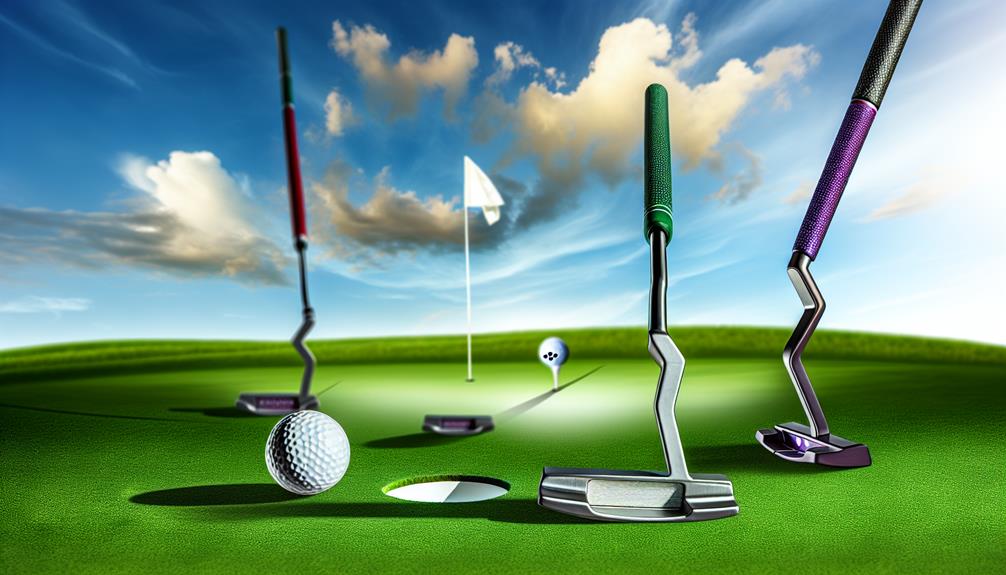In the serene tranquility of a golf course, the frustration of a missed putt can be startlingly jarring. You're not alone in this predicament, nor is it entirely your fault. Certain golf putters on the market today are designed to be exceptionally forgiving, reducing the impact of a bad stroke and improving your overall performance.
This begs the question: why are these golf putters so forgiving? What sets them apart from the rest? In the following analysis, we'll pull back the curtain to reveal what makes these putters your best allies on the green.
You might just find that a change in your golf bag can do wonders for your game. Hold onto your clubs; we're about to venture into a new dimension of golfing expertise.
Understanding Forgiveness in Golf Putters
Before diving into the list of most forgiving golf putters, it's crucial to understand what 'forgiveness' means in this context. Forgiveness in putters refers to their ability to produce a decent shot, even when you don't hit the sweet spot. It's about reducing the penalty for your mistakes, allowing you to maintain control and accuracy.
The putter design evolution plays a significant role in this aspect. Over the years, golf equipment manufacturers have employed advanced technology and innovative design concepts to increase the forgiveness of putters. They've expanded the sweet spot, improved weight distribution, and optimised face technology. These enhancements have dramatically impacted the putters' performance, making it easier for golfers of all skill levels to achieve consistent results.
Review of Top Forgiving Putters
Let's delve into the specifics and scrutinize some of the top golf putters renowned for their exceptional forgiveness. Advances in putter technology have led to the development of models with groundbreaking forgiveness features.
For instance, the Odyssey White Hot Pro 2.0 Putter stands out with its consistent response and impressive accuracy, thanks to its re-engineered White Hot insert.
The TaylorMade Spider X Putter, incorporating True Path Alignment technology, provides an unusual level of forgiveness. Its design aids in visualizing the intended path, leading to more successful putts.
Cleveland Golf Huntington Beach Soft Putter, on the other hand, boasts a speed-optimized face technology. This unique design helps normalize the speed of your putts across the entire face, thus increasing forgiveness.
The impact of putter design on forgiveness can't be understated. The Ping Sigma 2 Valor Stealth Putter, with its high MOI design, offers incredible forgiveness. It uses dual-durometer PEBAX face insert, ensuring soft feel and consistent performance.
Key Features of Forgiving Putters
Having examined some of the most forgiving putters, it's crucial to identify the key features that make these golf aids exceptionally forgiving. Two major factors that greatly contribute to the forgiveness of a putter are its material choices and weight impact.
Putter Material Choices play a significant role in providing forgiveness. Putters made of softer materials, such as polymer inserts, offer a more responsive feel and better distance control, which can help to mitigate the effects of mis-hits. On the other hand, putters made of harder materials, like milled steel, can provide more consistency and accuracy.
Putter Weight Impact is another crucial factor. A putter with a heavier head can provide more stability and control, reducing the chance of twisting upon impact and hence making it more forgiving. Conversely, a lighter putter may enable faster swings but may also lead to increased errors.
In essence, the most forgiving putters utilize optimal material choices and strategic weight distribution to mitigate the consequences of imperfect shots. By understanding these key features, you're better equipped to select a putter that complements your playing style while offering maximum forgiveness.
Comparing Forgiveness Levels in Putters
When you're looking to compare different putters based on their forgiveness levels, it's essential to consider both the material and weight distribution of each putter.
Putter materials impact the overall performance significantly. For example, steel putters, known for their durability and control, mightn't be as forgiving as their graphite counterparts, which offer greater flexibility and shock absorption.
Weight distribution, on the other hand, affects how the putter interacts with the golf ball. A putter with a higher concentration of weight towards the clubface tends to have a larger sweet spot, the area on the clubface where the ball is struck most efficiently. This sweet spot significance shouldn't be overlooked, as hitting the sweet spot consistently can lead to more accurate putts.
To make an informed decision, analyze the putter's design elements like loft, face balance, and alignment aids. These elements combined with the putter material and weight distribution will give you a comprehensive understanding of its forgiveness level.
Buyer's Guide: Choosing a Forgiving Putter
Choosing a forgiving putter demands a keen understanding of your playing style and the putter's design features. It's not merely about picking up the shiniest club in the store. Instead, it's about putter customization and material selection, which can significantly influence your performance on the green.
In terms of putter customization, consider the design of the putter's head. Larger mallet-style heads are typically more forgiving due to their high moment of inertia. Also, consider the weight distribution. Putters with perimeter weighting can help stabilize your strokes, making them more forgiving for off-center hits.
Material selection is equally important. Different materials produce different feels and sounds when the ball is struck, which can affect your confidence and performance. Titanium, for example, offers a light-weight feel and a soft sound. Stainless steel, on the other hand, provides a heavier feel and a more solid sound.

